© 2014-


Radio Caroline South - History
1964
Radio Caroline South came on the air at 6.00am on 4th July 1964 from the former Radio Atlanta ship, Mi Amigo, following the merger of the two rival stations. The original Radio Caroline ship, MV Caroline, sailed to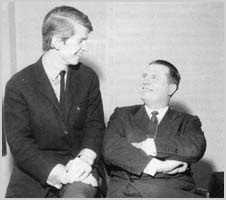 the Isle of Man to become Radio Caroline North.
the Isle of Man to become Radio Caroline North.
With the two sister stations Radio Caroline was now able to offer audiences and advertisers what was, in theory, a national daytime commercial radio station. However, the North and South stations each broadcast their own independent programmes and developed quite separate identities.
On Radio Caroline South the former Radio Atlanta transmission hours of 6.00am-
Although the outlook appeared promising for the new 'national' offshore station some unexpected problems arose from the merger. Several Atlanta DJs refused to join the new Caroline network and Radio Atlanta General Manager, Leslie Parrish, resigned over a difference of opinion on policy matters.
On Caroline South, over which Allan Crawford retained a significant degree of control, DJs were continually being instructed to play his record company's cover versions of hit singles -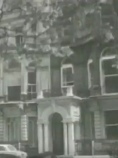
Shortly before the merger Radio Caroline had moved its administrative headquarters to a large three storey building at 6 Chesterfield Gardens -
In order to deal with th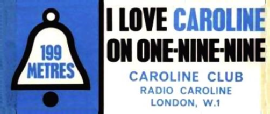 e vast number of enquiries from listeners for information about the station and for items of publicity material such as badges and car stickers, the Caroline Club had been launched shortly before the merger with Radio Atlanta. After the merger on 2nd July, the Caroline Club was extended to offer membership to listeners on a nationwide basis and the first "Caroline Club Requests" programme was aired on Radio Caroline South on 11th July 1964.
e vast number of enquiries from listeners for information about the station and for items of publicity material such as badges and car stickers, the Caroline Club had been launched shortly before the merger with Radio Atlanta. After the merger on 2nd July, the Caroline Club was extended to offer membership to listeners on a nationwide basis and the first "Caroline Club Requests" programme was aired on Radio Caroline South on 11th July 1964.
In October 1965 the Mi Amigo moved her anchorage to a position in the Black Deep near the Red Sands and Shivering Sands Thames Estuary forts in an attempt to get a stronger signal into London. However, it soon became apparent that this anchorage was more exposed and the ship was badly affected by rough seas. This, together with the realisation that the location was now within territorial waters as defined by the recently introduced Territorial Waters Order in Council, led to the Mi Amigo sailing back to her former anchorage off Frinton on Sea a week later.
Early in December 1964 a new rival for Caroline South arrived in the Thames Estuary -
However, the board of Radio London rejected the merger offer. Ronan O’Rahilly did, however, point out to the Radio London team that their planned anchorage (near the Shivering Sands Fort) was now within territorial waters, resulting in their move to a position off Frinton on Sea near the Mi Amigo.
1965
As 1965 dawned both Radio Caroline stations were undoubtedly market leaders in offshore commercial radio, but Caroline South's position was about to be seriously challenged by Radio London, which had arrived just before Christmas 1964.
Radio Caroline appointed a representative in New York - ffice on Broadway. Bernard, who was in fact British, managed a few promotions for Caroline, including Miss Radio Caroline (model Denine Fiore) who helped promote the station to advertising agencies, and the appearance of Ronan O’Rahilly on a US TV programme -
ffice on Broadway. Bernard, who was in fact British, managed a few promotions for Caroline, including Miss Radio Caroline (model Denine Fiore) who helped promote the station to advertising agencies, and the appearance of Ronan O’Rahilly on a US TV programme -
A milestone wa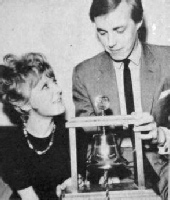 s reached at Easter 1965 when Radio Caroline celebrated its first birthday. To mark the occasion the station introduced four 'Bell Awards' which were presented to various artists for their contribution to musical entertainment during the preceding twelve months. Recipients were -
s reached at Easter 1965 when Radio Caroline celebrated its first birthday. To mark the occasion the station introduced four 'Bell Awards' which were presented to various artists for their contribution to musical entertainment during the preceding twelve months. Recipients were -
- The Animals -
best group record of the year (House of the Rising Sun) - The Beatles -
best and most consistent artists - Petula Clark -
best female recording (Downtown) - Tom Jones -
best male recording (It's not Unusual)
Birthday messages and greetings from over twenty artists were also recorded and included in programmes on both the North and South Caroline stations during the Easter weekend.
At the end of its first year on the air, in March 1965, Radio Caroline had achieved advertising income of £294,000, with estimated running costs put at between £100,000 and £150,000. This was a significant achievement in a market environment largely unfamiliar with the use of radio as an advertising medium. Unfortunately for the station, much of this advertising revenue had been earned during its first nine months, prior to the arrival in late December 1964 of Radio London. The impact of this new rival can be demonstrated by advertising revenue figures for March 1965 which show that Caroline South was struggling to achieve an average income of just £1,000 per week. The growing popularity and professionalism of Radio London contrasted strongly with the weaknesses of Radio Caroline's management structure,commercial airtime sales techniques and broadcast signal strength. These deficiencies were to cause further internal problems at Radio Caroline later in the year.
It was decided to revamp the station's tired and out-
Unfortunately this sudden transformation in style and format -
The reason for this was that during late 1964, before Radio London's launch, Caroline had succeeded in selling a large number of 15 and 30 minute sponsored shows which were produced directly by advertising agencies (mainly J Walter Thompson and S H Benson) on behalf of their clients. The sponsors included significant national brands such as Player's Anchor cigarettes, Andrews Liver Salts, Princes Foods, Chappell Pianos, Fynon Liver Salts and Miners Make-
Many of the contracts were for daily or weekly segments to be broadcast over periods of 13 or 26 weeks -
The revamp of Radio Caroline's format did have some success though and resulted in increased interest from audiences and advertisers. An indication of the dramatic decline in Radio Caroline's advertising revenue after the arrival of Radio London in December 1964 and of a revitalisation after the format changes in April 1965 can be seen from these monthly advertising income figures:-
November/December 1964 £47,952 (before Radio London arrived)
December 1964/January 1965 £28,721 (after Radio London's initial broadcasts)
January/February 1965 £32,558 (after Radio London’s initial broadcasts)
March/April 1965 £32,341 (after Radio Caroline's format revamp)
April/May 1965 £49,259 (after Radio Caroline's format revamp)

First Birthday greetings from the stars, March 1965

Ronan O’Rahilly and Allan Crawford
Caroline House,
6 Chesterfield Gardens
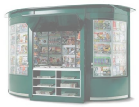

Click on picture to enlarge
Caroline Good Guy jingle

Petula Clark receiving her Caroline Bell Award from DJ Simon Dee
Birds Eye Florida Orange Juice



History
Key Dates
Ship and Location
Technical
Staff
Programmes







Back to Radio Caroline South

Treasure Chest

Ronan O’Rahilly appearing on the American TV game show, To Tell the Truth, 3rd March 1965
Jack Spector

Disc
11th July 1964

Billboard
27th March 1965

Daily Mail
9th June 1965
(Visit of Prince Richard of Gloucester to Radio Caroline South)




Back to Britain Gallery

